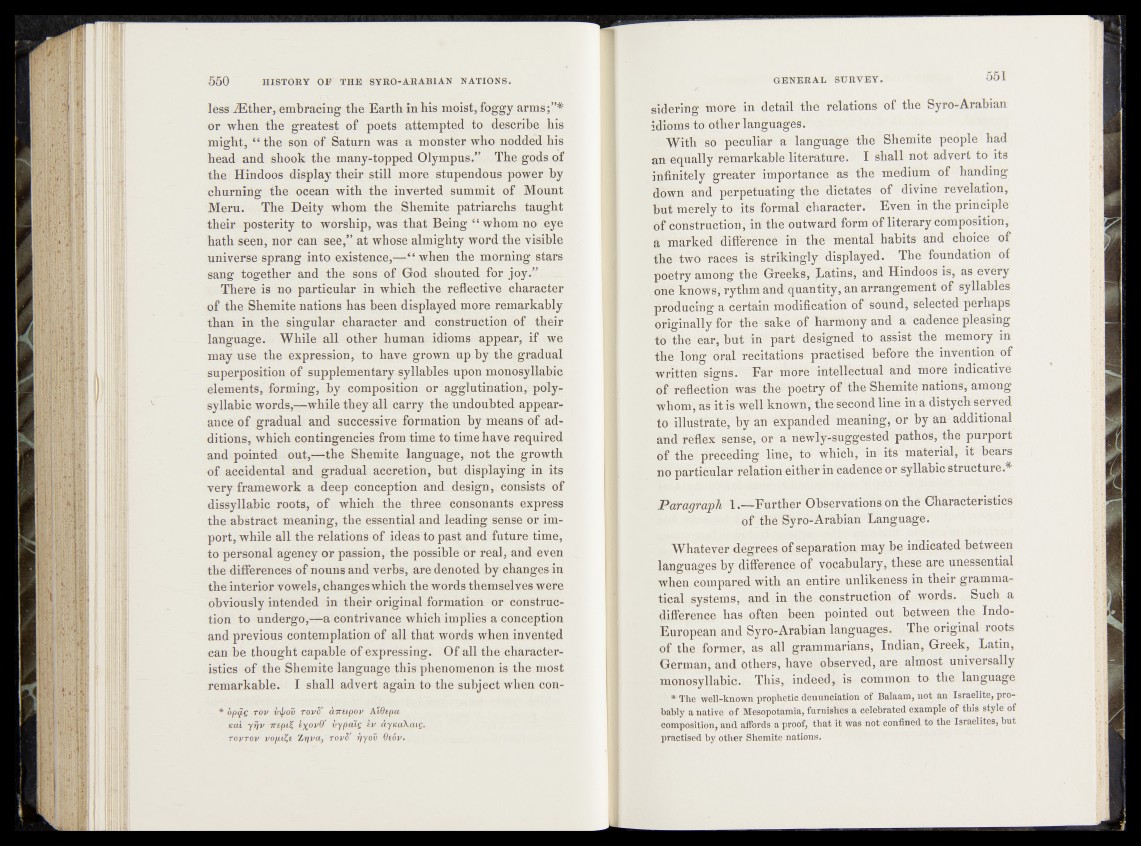
less iEther, embracing the Earth in his moist, foggy arms;”*
or when the greatest of poets attempted to describe his
might, “ the son of Saturn was a monster who nodded his
head and shook the many-topped Olympus.” The gods of
the Hindoos, display their still more stupendous power by
churning the ocean with thff*inverted summit of Mount
Meru. The Deity whom the Shemite patriarchs taught
their posterity to worship, was that Being “ whom no eye
hath seen, nor can see/’ at whose almighty word the visible
universe sprang into existence,—“ when the morning stars
sang together and the sons of God shouted for joy^’ 1
There is no particular in which the reflective character
of the Shemite nations has been displayed more remarkably
than in the singular character and construction of their
language. While all other human idioms appear, if we
may use the expression, to have grown up by the gradual
superposition of supplementary syllables upon monosyllabic
elements, forming, by composition or agglutination, polysyllabic
words,—while they all carry the undoubted appearance
of gradual and successive formation by means-of additions,
which contingencies from time to time have required
and pointed out,-—the Shemite language, not the growth
of accidental and gradual accretion, b utv displaying in its
very framework a deep conception and design, consists of
dissyllabic roots, of which the three consonants express
the abstract meaning, the essential and leading sense or imr
port, while all the relations of ideas to past and future time;
to personal agency or passion, the possible or realr and even
the differences of nouns and verbs, are denoted by changes in
the interior vowels, changes which the words themselves were
obviously intended in their original formation or construction
to undergo,—a contrivance which implies a conception
and previous contemplation of all that words when invented
can be thought capable of expressing. Of all the characteristics
of the Shemite language this phenomenon is the most
remarkable. I shall advert again to the subject when con*
opq,Q tov iip o v tovS' aTrupov AWepa
g a l y f jv irspiZ k%ovff v y p a ig I v &yica\cue-
tovtov Zrjvct, r o v ff fjy o v Qtov.
sidering more in detail the relations of the Syro-Arabian
idioms to other languages.
With so peculiar a language the Shemite people had
an equallytflmarkabliditeratiStfe^' I ”shall not advert to its
infinitely greater importance as the medium of handing
down and perpetuating the dictates of divine revelation,
but mgtfely to its :formaPcharacter. Even in the principle
oftconstruction; in the outward form ofliterary composition,
a marked difference in the mental habits and choice of
the two races is strikingly displayed. The foundation of
poetry among the Greeks/^Ehtihs^ and Hindoos is, as every
one knows1; rythni and quantity, an arrangement of syllables
producing a certain rifbdification of sound ^elected perhaps
originally5 for the sake of harmony and a cadence pleasing
tb the ear, but in part designed to assist the memory in
the long oral recitations" practised before the invention of
written signs. Far more intellectual and tnore indicative
of reflection was the poetry df the Shemite nations, among
whofoli as it m well kndw^fh^bcond line in a distyfch served
to illustrate, by an expanded meaning, or by an additional
and reflex sense, or a newly-suggested pathos, the purport
bf the preceding litfe^tb wh i c h i t s material, it bears
no particular relation either in cadenSd or syllabic structure.*
Paragraph 1.—Further Observations on the Characteristics
o f the Syro-Arabian Language?1
Whatever degrees of separation may be indicated between
languages by difference, of vocabulary, these are unessential
when compared with an entire unlikeness in their grammatical
systems, and in the construction of words. Such a
difference has often been pointed out between Indo-
European and Syro-Arabian languages. The original roots
of the former, as all grammarians, Indian, Greek, Latin,
German, and others, have observed, are almost universally
monosyllabic. „ This, indeed,, is- common to the language
' * The well-known prophetic denunciation of Balaam, not an Israelite, probably
a native of Mesopotamia, furnishesa celebrated example of this style of
composition, and affords a proof, th a t it was not confined to the Israelites, but
practised by other Shemite nations.